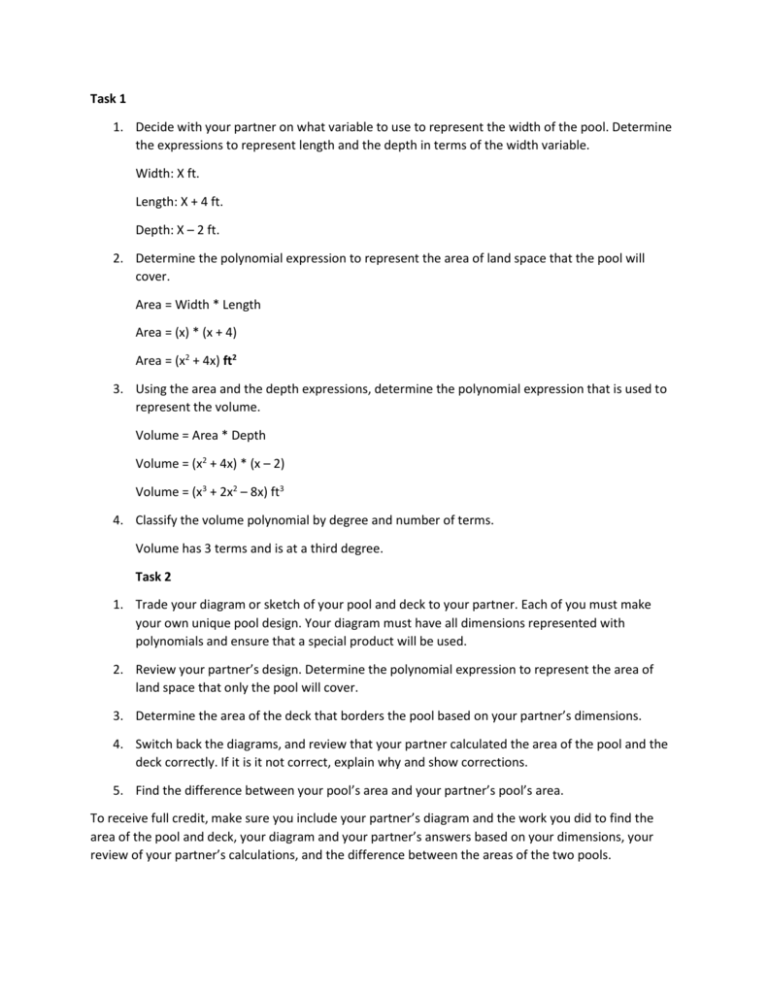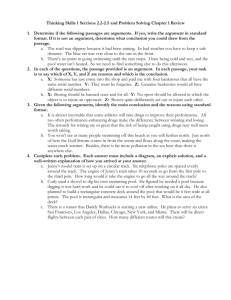tak - OpenStudy
advertisement

Task 1 1. Decide with your partner on what variable to use to represent the width of the pool. Determine the expressions to represent length and the depth in terms of the width variable. Width: X ft. Length: X + 4 ft. Depth: X – 2 ft. 2. Determine the polynomial expression to represent the area of land space that the pool will cover. Area = Width * Length Area = (x) * (x + 4) Area = (x2 + 4x) ft2 3. Using the area and the depth expressions, determine the polynomial expression that is used to represent the volume. Volume = Area * Depth Volume = (x2 + 4x) * (x – 2) Volume = (x3 + 2x2 – 8x) ft3 4. Classify the volume polynomial by degree and number of terms. Volume has 3 terms and is at a third degree. Task 2 1. Trade your diagram or sketch of your pool and deck to your partner. Each of you must make your own unique pool design. Your diagram must have all dimensions represented with polynomials and ensure that a special product will be used. 2. Review your partner’s design. Determine the polynomial expression to represent the area of land space that only the pool will cover. 3. Determine the area of the deck that borders the pool based on your partner’s dimensions. 4. Switch back the diagrams, and review that your partner calculated the area of the pool and the deck correctly. If it is it not correct, explain why and show corrections. 5. Find the difference between your pool’s area and your partner’s pool’s area. To receive full credit, make sure you include your partner’s diagram and the work you did to find the area of the pool and deck, your diagram and your partner’s answers based on your dimensions, your review of your partner’s calculations, and the difference between the areas of the two pools. Partner’s design: Area of Pool: Area = (x + 4) * (x) Area = (x2 + 4x) ft2 Area of Deck: Area = (x + 7) * (x + 5) – Area of Pool. Area = (x2 + 12x + 12) – (x2 + 4x) = (8x + 12) Area = (8x + 12) ft2 My Design: Area of Pool: Area = (x + 4) * (x) Area = (x2 + 4x) ft2 Area of Deck: Area = (x + 2) * (x + 6) – Area of Pool. Area = (x2 + 8x + 8) – (x2 + 4x) = (4x + 8) Area = (4x + 8) ft2 Difference between the pool decks: My partner’s had an area of (8x + 12) ft2 My pool had an area of (4x + 8) ft2 Difference: (8x + 12) ft2 - (4x + 8) ft2 = (4x + 4) Task 3 Now that you have helped Bernard design the pool, he presents you with a situation. There are x number of communities that will be designing homes with the pools. The number of homes within each community is six more than the number of communities. The number of hours that will be required to build each home is double the number of homes in each community. 1. Since x represents the number of communities, determine the two other expressions used to represent the number of homes for each community and the number of hours required to build each home. Number of communities = x Homes per community = x + 6 Hours per home = 2x + 12 2. Using the three expressions, interpret the meaning of each grouping of factors as a single unit, and also simplify each expression by finding their product. Number of communities = x Homes per community = x + 6 Total number of homes = x(x + 6) = x2 + 6x Hours per home = 2x + 12 Total number of hours for all homes = (x2 + 6x)(2x + 12) = 2x3 + 24x2 + 72x 3. Explain how polynomials demonstrated the closure property throughout this exploration We multiplied polynomials throughout the process. To demonstrate the closure property, the result will always be a polynomial.






